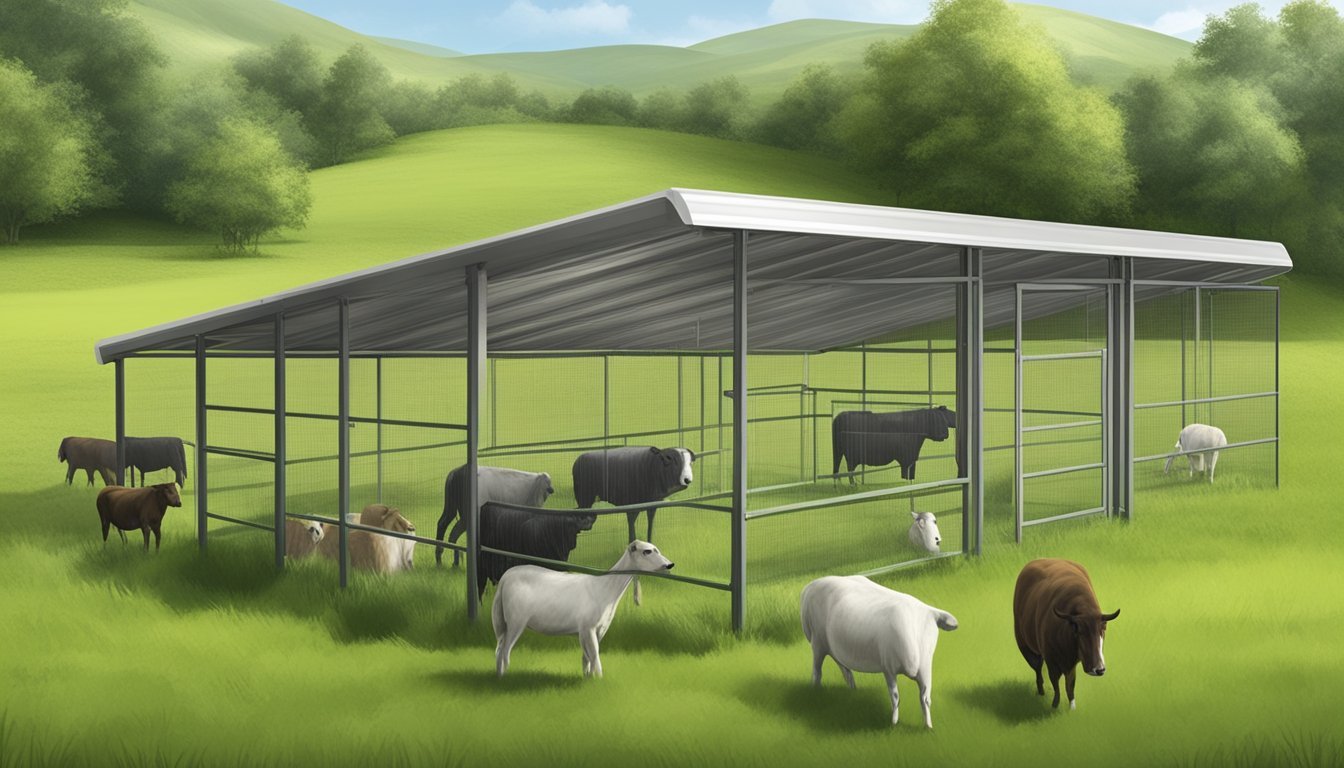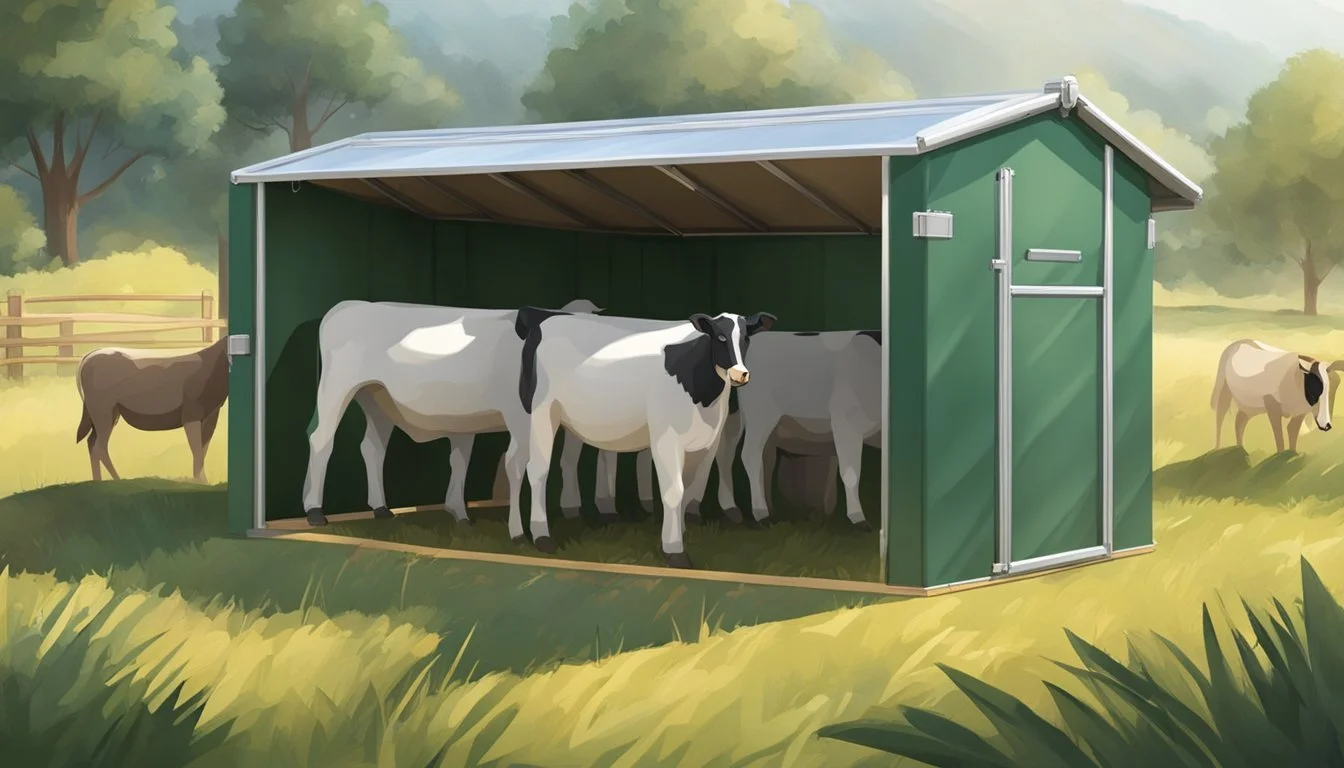Quick and Easy Portable Animal Shelter
Essential Protection for Homestead Livestock
For homesteaders, ensuring the safety and comfort of their livestock is a pivotal aspect of sustainable living. Portable animal shelters have emerged as a practical solution, offering protection against environmental elements and predators. These shelters, designed to be easily relocatable, cater to the dynamic needs of a homestead. The design options range from simple three-sided structures to more complex barn-like models, ensuring there’s a match for various livestock types, from goats to larger farm animals.
The advantages of portable shelters for livestock are manifold. They grant flexibility in pasture management, allowing farmers to rotate their animals and prevent overgrazing. Shelter is one of the most basic animal needs, and portable shelters fulfill this requirement while also offering versatility. Constructed from durable materials such as heavy-duty metal framing and waterproof coverings, they ensure that animals remain dry and shielded from harsh weather.
Moreover, portability simplifies maintenance tasks like cleaning and sanitation. These shelters negate the need for permanent structures, thus saving time and resources. For the homesteader, a portable livestock shelter is not just a convenience; it is an essential tool in the arsenal for protecting their investment and enhancing the welfare of their animals.
Understanding the Need for Livestock Shelters on Homesteads
Livestock shelters are essential for safeguarding animals from diverse environmental conditions and predators. They serve as a basic necessity to ensure the well-being and safety of farm animals on a homestead.
Climate Challenges for Livestock: From Rain to Cold
Rain and Moisture: Livestock exposed to heavy rainfalls can suffer from skin problems and hoof issues. Providing a -shelter helps to keep them dry and prevents conditions such as foot rot. A list of elements required for weather protection in shelters may include:
Roofing material (corrugated metal or reflective tarp) to divert rain
Raised foundation (using concrete blocks or wood posts) to prevent water pooling
Temperature Extremes: Animals are vulnerable to the cold, affecting their health and productivity. Insulation and windbreaks become critical.
Protective Solutions:
Insulation methods: installation of plywood siding or heat-retaining materials
Ventilation systems: to allow proper airflow while retaining warmth
Protection Against Predators
Farm animals are at risk from various predators, including coyotes, foxes, and birds of prey. Durable barriers and secure enclosures are non-negotiable features of an effective livestock shelter.
Shelter Characteristics for Safety:
Materials: Using heavy-duty wire fencing or solid planks can prevent predator penetration.
Design: Ensuring no gaps or weak points exist in the shelter structure to deter entry.
Key Aspects of Portable Animal Shelters
For homesteaders, portable animal shelters are essential for offering flexible, convenient protection for livestock. They provide quick assembly and relocation capabilities, ensuring animals have shelter wherever it's needed.
The Importance of Portability
Portability is a cornerstone feature of these shelters, offering homesteaders the flexibility to relocate their livestock enclosures as required. The shelters are typically lightweight structures, some small enough to weigh only 145 lbs for ease of mobility. For instance, portable goat shelters can often be moved by a couple of people or even by the animals themselves.
Material Considerations for Durability and Safety
Choice of materials significantly impacts the durability and safety of the shelter. Metal is often used for frames to ensure sturdiness, while materials like T1-11 siding provide resilient walls. Cattle panels, which are durable and versatile, are frequently employed for the frame's construction. It's crucial to secure the panels with proper fastenings, ensuring no gaps are left that could compromise the enclosure or pose a risk to the animals.
Sizing and Space Efficiency
Sizing is critical; shelters need to balance ample space for animals while maintaining efficiency. A simple goat shelter, for example, needs to be large enough to offer shade and shelter but also small enough to avoid excessive space use. The sizing choice typically relates to the animal's size and the number of animals requiring shelter. A well-designed shelter optimizes space without sacrificing the animals' comfort.
Goat Shelter Specifics
When designing a goat shelter, homesteaders must consider the comfort of the goats and the different needs they have at various life stages. A good shelter protects goats from the elements, predators, and provides a cozy environment for their well-being.
Designing a Comfortable Goat Shelter
A comfortable goat shelter starts with space. Goats need ample room to move, rest, and engage in natural behaviors. Ventilation is also essential to prevent moisture build-up and maintain fresh air, which is vital for the goats' respiratory health. For this, an A-Frame design can be particularly beneficial, providing good air circulation. The roof is a pivotal element and should be slanted to ensure quick runoff of rainwater and snow.
Bedding inside the shelter is key for warmth and comfort. Materials such as straw or wood shavings are suitable choices. Here's a list of bedding properties to consider:
Absorbency: To manage waste and moisture effectively.
Insulation: To maintain a comfortable temperature year-round.
Ease of Cleaning: To ensure the shelter remains hygienic.
For those preferring a DIY goat shelter, using pallets can be cost-effective and customizable. This often involves simple construction techniques manageable even for beginners.
Shelter Needs for Different Goat Life Stages
The needs of goats change as they grow, which should be reflected in the design of their shelter. Kids and baby goats require a warmer area, protected from drafts, often necessitating additional insulation or heat sources in colder climes. For adult goats, shelters need to accommodate their size and social behavior, ensuring enough space for the hierarchy dynamics to play out without causing stress or injury.
Goat Shelter Dimensions for Different Life Stages:
Life Stage: Kids
Shelter Size: Smaller, more insulated areas within the larger shelter
Life Stage: Adults
Shelter Size: At least 15 square feet per goat inside the shelter
It is advisable to include partitions or separate zones within a larger shed to provide seclusion for goats that are birthing or need isolation due to illness. In conclusion, a thoughtfully designed goat shelter serves as a cornerstone of successful livestock management and a peaceful homestead.
Constructing Your Goat Shelter
Building a robust goat shelter requires a blend of practical building skills and the right selection of materials. Homesteaders can protect their livestock from the elements by constructing a reliable structure tailored to their goats' needs.
Do-It-Yourself (DIY) Shelter Building Techniques
DIY methodologies empower homesteaders to craft shelters with personal touches suited to their specific requirements. Leveraging wood pallets allows for a cost-effective and sturdy base for the shelter. For a simple pallet goat shed, one can transform used pallets into the framework of a three-sided structure, ensuring shelter against wind and rain with a slanted roof for effective drainage.
Choosing the Right Tools and Materials
Select tools and materials based on the complexity of the design and the desired durability:
Tools: Hammer, nails, saw, drill, measuring tape, and level.
Materials:
Framework: Lumber (2x4s and 2x6s), wood pallets for the base.
Roofing: Roofing material such as sheet metal or silage cover.
Siding: Plywood or additional lumber for wall construction.
Fasteners: Screws and nails suitable for wood.
Foundation (optional): Concrete for permanent structures.
Step-by-Step Shelter Construction Guide
Step 1: Lay out the wood pallets to create the floor plan.
Step 2: Cut and assemble lumber to erect the frame. Ensure the walls are secure and the front opening provides easy access.
Step 3: Attach plywood or additional boards to the exterior, leaving the front open to form a three-sided enclosure.
Step 4: Construct the roof with a slight angle towards the back of the shelter to prevent water accumulation.
Step 5: Fasten the roofing material—like sheet metal—to the frame, ensuring it overlaps the sides to provide adequate runoff.
Step 6: For enhanced stability, secure the structure to the ground, anchoring it if applicable.
Shelter Management and Maintenance
Proper management and maintenance of portable animal shelters ensure they remain functional, comfortable, and practical for livestock protection throughout the year. Attention to details such as shelter integrity, cleanliness, and adaptability to changing weather conditions is crucial for the welfare of the animals.
Routine Shelter Inspections and Repairs
Inspection Frequency: Conduct thorough inspections of portable shelters bi-weekly to detect issues like structural damage or wear.
Key Areas to Check:
Roof: Ensure the slanted roof is intact to prevent water accumulation.
Walls: Look for any breaches that could compromise the shelter's function.
Ventilation: Verify that ventilation remains good and unobstructed.
Repair Tips:
Immediate Action: Address any damage swiftly to maintain a dry area and prevent further deterioration.
Replacement Materials: Keep common repair materials on hand, such as tarps or fasteners.
Sanitation and Bedding Management
Cleaning Schedule: Clean shelters weekly to maintain a healthy environment.
Sanitation Practices:
Removal of Waste: Regularly dispose of waste to prevent buildup and disease.
Bedding Rotation: Replace or refresh bedding, such as hay, to keep a comfortable resting area.
Bedding Features:
Absorbent: Use materials that absorb moisture effectively.
Comfort: Ensure bedding provides comfort and warmth.
Shelter Adaptations for Changing Seasons
Seasonal Adjustments:
Summer: Implement measures to increase airflow and shade to mitigate heat.
Winter: Strengthen the shelter against snow and cold with additional insulation.
Adaptability Features:
Portable Furnishings: Equip the shelter with movable furniture like hay feeders or goat enclosures that can be easily adapted.
Tall Goat Shelter: For taller livestock, maintain an appropriate height to ensure comfort during all seasons.
Enhancing Goat Comfort and Livestock Welfare
In a well-designed portable animal shelter, the comfort and welfare of goats are paramount. Attention to ventilation, protection, and shelter amenities directly impacts herd health and productivity.
Effective Ventilation and Insulation Techniques
Well-ventilated shelters ensure a continuous flow of air which is crucial for maintaining a healthy environment for livestock. Insulated shelters can protect goats from extreme temperatures. For example, ShelterLogic offers insulated and breathable shelter options that provide a comfortable temperature year-round. The Alaskan goat igloos are another innovative solution, designed specifically for cold climates, keeping goats warm without sacrificing air quality.
Balancing Open Space with Protection
Goats require enough space for free movement, which contributes to their well-being. A spacious shelter allows for rotational grazing management, which can improve pasture conditions and herd health. A standard guideline is to allocate 10-15 square feet of shelter space per goat. Portable shelters are generally accessible and can have a plastic canopy to shield from rain while still offering the openness goats need.
Add-On Features for Goat Shelters
Add-on features can enhance the functionality of goat shelters. A goat tower can serve as an enriching playground, while storage areas keep supplies dry and organized. The inclusion of a milking area within the shelter can streamline the milking process. Each shelter can be customized with specific add-ons to meet the unique needs of the herd, such as feeders, storage units, or even nesting boxes for kidding.



